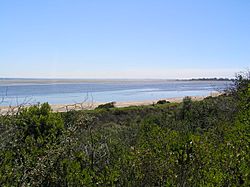Swan Bay facts for kids
Quick facts for kids Swan Bay |
|
|---|---|

Swan Bay at low tide, looking north from Queenscliff
|
|

Map of Swan Bay
|
|
| Location | Bellarine Peninsula, Victoria |
| Coordinates | 38°13′43″S 144°39′12″E / 38.22861°S 144.65333°E |
| Type | Saline, Permanent, Natural |
| Primary inflows | Yarram Creek, Frederick Mason Creek |
| Primary outflows | Port Phillip |
| Basin countries | Australia |
| Surface area | 30 km2 (12 sq mi) |
| Average depth | 2 m (6 ft 7 in) |
| Max. depth | 5 m (16 ft) |
| Islands | Duck, Mangrove, Rabbit, Sand, Stingaree, Swan, Tip |
| Settlements | Queenscliff, St Leonards |
Swan Bay is a beautiful, shallow bay in Victoria, Australia. It covers about 30 square kilometers (about 11.5 square miles). You can find it at the eastern end of the Bellarine Peninsula, which is a piece of land sticking out into the water.
The bay is part of a larger body of water called Port Phillip. The towns of Queenscliff and St Leonards are located along its shores. Swan Bay is partly separated from Port Phillip by three islands: Swan Island, Duck Island, and Edwards Point.
This bay is very important for nature. Most of it is part of the Port Phillip Heads Marine National Park. It's also recognized internationally as a special wetland under the Ramsar Convention. This means it's a protected area because of its importance for many different birds.
The famous explorer Matthew Flinders named the bay "Swan Ponds." He saw many black swans there. In fact, up to 2,700 black swans can be seen in the bay during summer and early autumn!
Contents
Why Swan Bay is Special for Nature
Swan Bay is a very important place for many animals, especially birds. It has different natural areas that help these creatures live and grow.
Important Ecosystems in Swan Bay
The bay is home to several important ecosystems:
- Salt marshes: These are coastal wetlands flooded by salty water.
- Mudflats: These are flat, muddy areas exposed at low tide.
- Seagrass beds: These are underwater meadows of seagrass.
Almost everything living in the bay relies on these seagrass beds for food. Even though much of the land around the bay is used for farming, some natural woodland areas still exist. You can find these in the nearby Edwards Point Nature Reserve. Because of its rich nature, Swan Bay is recognized as having international importance.
Birds of Swan Bay
Nearly 200 different kinds of birds have been seen in Swan Bay. Many of these birds are very important for conservation. The bay and its shores are especially important for:
- The critically endangered orange-bellied parrot. This bird is very rare and needs special protection.
- Other important birds like the little tern, fairy tern, eastern curlew, Lewin's rail, and white-bellied sea eagle.
Swan Bay also supports more than 1% of Australia's population of four types of wader birds. Waders are birds that feed in shallow water or on mudflats. These include the Grey plover, Pacific golden plover, double-banded plover, and the eastern curlew.
Other birds you might see in the area are the Australian pelican, silver gull, royal spoonbill, and different kinds of terns like the Caspian and crested terns. You might also spot a white-fronted chat, sacred ibis, red-necked stint, little pied cormorant, and pied oystercatcher. Some of these amazing birds travel thousands of miles! They come all the way from places like Arctic Siberia and Alaska to feed on the muddy areas of Swan Bay.
Exploring Swan Bay
Swan Bay is a great place for outdoor activities, especially those that let you enjoy nature.
Fun Activities in the Bay
Many people enjoy sightseeing activities in Swan Bay, such as:
- Sea kayaking: Paddling a small boat on the water.
- Scuba diving: Exploring underwater with special breathing gear.
- Bird watching: Looking for and identifying different bird species.
- Wildlife tours: Guided trips to see the animals and plants.
Boating in Swan Bay
Boating in Swan Bay has some rules because the water can be shallow. There is a 5-knot speed limit in many areas, especially around Swan Island and in Stingaree Bight. At low tide, some parts of the bay become very shallow, so it's important to be careful if you are boating.


